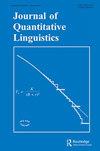Syntactic Complexity of Different Text Types: From the Perspective of Dependency Distance Both Linearly and Hierarchically
IF 1.7
2区 文学
0 LANGUAGE & LINGUISTICS
引用次数: 0
Abstract
ABSTRACT Dependency distance (DD) is a well-established measure of syntactic complexity. Previous studies largely focused on the linear dimension, mostly by mean of dependency distance (MDD). In the present study, a new quantitative indicator –mean hierarchical dependency distance (MHDD), is proposed to discuss DD-related issues. Combining MHDD and MDD, the study investigates syntactic complexity of different texts, using strictly length-controlled sentences of 12 text types from the Freiburg-Brown corpus of American English. Correlations of MHDD and MDD have been identified, and possible reasons are discussed from the mathematical and theoretical perspectives. Mathematically, one is that the numerator of MHDD overlaps with the denominator of MDD, both being (n-1) where n is the number of words in the sentence. The other is that the denominator of MHDD (maximum hierarchical layer: MAXHL) and the numerator of MDD (sum of DD: SOD), are positively correlated. We believe that it is the positive correlation of SOD and MAXHL that ensures the change of MDD and MHDD in the same direction. It is also worth noting that both MAXHL and SOD seem to be minimized at their respective data spectrum, which foreshadows the dependency distance minimization (DDM) tendency on the hierarchical dimension.不同文本类型的句法复杂性:从线性和层次依赖距离看
依赖距离(DD)是一种公认的衡量句法复杂性的方法。以前的研究主要集中在线性维度上,主要是通过依赖距离(MDD)的平均值。在本研究中,提出了一个新的定量指标——平均层次依赖距离(MHDD),以讨论DD相关问题。本研究将MHDD和MDD相结合,使用美国英语弗赖堡-布朗语料库中12种文本类型的严格长度控制句子,研究了不同文本的句法复杂性。已经确定了MHDD和MDD的相关性,并从数学和理论角度讨论了可能的原因。从数学上讲,一种是MHDD的分子与MDD的分母重叠,两者都是(n-1),其中n是句子中的单词数量。另一种是MHDD的分母(最大层次层:MAXHL)和MDD的分子(DD:SOD之和)呈正相关。我们认为,正是SOD和MAXHL的正相关关系确保了MDD和MHDD朝着同一方向变化。同样值得注意的是,MAXHL和SOD似乎都在各自的数据谱上最小化,这预示着层次维度上的依赖距离最小化(DDM)趋势。
本文章由计算机程序翻译,如有差异,请以英文原文为准。
求助全文
约1分钟内获得全文
求助全文
来源期刊

Journal of Quantitative Linguistics
Multiple-
CiteScore
2.90
自引率
7.10%
发文量
7
期刊介绍:
The Journal of Quantitative Linguistics is an international forum for the publication and discussion of research on the quantitative characteristics of language and text in an exact mathematical form. This approach, which is of growing interest, opens up important and exciting theoretical perspectives, as well as solutions for a wide range of practical problems such as machine learning or statistical parsing, by introducing into linguistics the methods and models of advanced scientific disciplines such as the natural sciences, economics, and psychology.
 求助内容:
求助内容: 应助结果提醒方式:
应助结果提醒方式:


